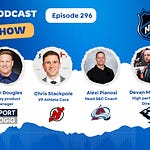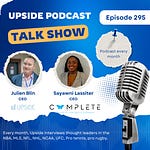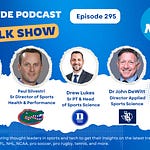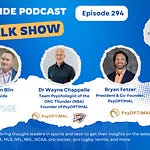This week we have the honor to interview again a group of sports performance experts focusing on rehab/return to play.
Jason Han, the Head of Rehabilitation / Team Physical Therapist. at LAFC (MLS team).
Dr. Marco Nunez, the Former Head Athletic Trainer at the LA Lakers (NBA).
Kevin Martin, the CEO of The Quick Board, which developed a visual training and rehab technology.
📝Show Notes: Through this interview, we touched on the future of VR and AI for sports rehab. We also touched on the team behind the team and how to best integrate athletes’ private staff into a team setting. We also discussed the use cases for emerging technologies such as robotic massage tables and a new study.
Best Quotes: Here’s some of the key discussion points and best quotes from our conversation with Kevin, Jason and Marco:
On the best way to manage athletes’ private coaches into a team setting:
Dr Marco Nunez:
“ I guess the funny situation with that is I've been in both shoes (staff member of a team and independent AT) and I'm currently on the other side. So when I was with the LA Lakers, that's one of the issues that I saw, and I was a bit concerned as it started to happen in 2010 with some players hiring their private staff such as strength coaches or physical therapists”.
“And I remember as a staff, we sat down with the GM of the LA Lakers and we had to decide, okay, you know, we're going to take one or two approaches. Either one, we're going to say, no, we're going to cut it off. We're not going to allow it and just completely ban it. And if we do that, are we going to lose the player or are we not going to ban it?”.
“And I think one of the advantages that I have now is that when I have been sitting with the head athletic trainer of a team, I told him, Hey, I was in your shoes. I understand where you're coming from and I understand the communication that you need. And I think it eased his mind and also eased the GM's mind (..) So I think that communication helps ease everybody and I was able to continue working and I still continue a line of communication with teams every week”.
“Sometimes private coaches have to make the team look bad so they can make themselves look good in a sense, which kind of sucks. And I'm taking the opposite approach. I'm not badmouthing the team. I'm like, Hey, they're there to help you. I'm working with them. And I communicate with the player that, Hey, this is what I'm going to tell the team and this is what they told me. And so there's a line of communication. And I've noticed that so far it has worked for me”.
Jason Han:
“We have to know our limitations and not take things too personally. If we are short staffed and we're not able to give this athlete as much time or attention as he or she deserves, then maybe it might be a good thing that they're going to the outside. So at least us at LAFC, we've evolved over time where we started with a staff of three on the medical side and now we're at a staff of five”.
“That was communication within our organization and with the GM where we let him know “Hey, we're bringing in big players that are used to a certain level of care in Europe. When they come to the States, we don’t want to tell them “it's not the way that we do things here.” So if we want the league and the team to move in a positive direction, we're going to have to up our game”.
“So it's about communicating and then controlling the controllables within our own team. So at least that’s my experience within the MLS where it's quite rare during the season to work with someone that is on the outside or someone has their own guy. But during the off season, it's very common, especially with our athletes that live outside of the country. We have to vet, talk or meet with them”.
“As Marco said, we speak with our players on a weekly basis. If we need some objective measures, we try to make sure that they're able to send that to us and we are communicating with the athlete themselves through video calls. So to summarize it's important to focus on communication and knowing our limitations as well”.
Kevin Martin:
“Communication is obviously paramount. And also on both sides you need to have the willingness to work with each other, which, as you guys talked about, has become more common. And I think on the private side, not the team side, in terms of fear of losing the athlete, who may be your guy, if that individual is confident in his ability and they're good at what they do, they ought to increase that relationship with the team and show them, Hey, look, I'm communicating every step of the way, and keeping in touch with you”.
“Sharing those objective measures and milestones is going to help the team, not only the player, but the team may start referring to them and it's going to be a win, win for everyone”.
On the future of AI (ChatGPT..) for sports rehab:
Jason Han:
“When ChatGPT was coming out, I started to play with it. I used it to look at things like rehab protocols. So I think there's a bright future with AI. But as of right now, it's not at a point where it's going to do everything for you. I look at it as a resource”.
“If you're a professional and you've been doing it for a long time. You've developed your flow, but it's also good to cross reference it with other clinicians or maybe an AI platform that spits out a rehab protocol. I'm like, oh, I didn't think about this. So to me it's really a check and balance and a way to make your process even better”.
“And regarding using an AI generated rehab program, one thing to keep in mind is that it really depends on who the surgeon is and the method that they use. There's all these little intricacies that makes me think that it's just not there yet, but as a general guideline, I like the concept of using AI to generate AI based rehab programs”.
Dr Marco Nunez:
“I always say, whenever I am doing seminars or some talks, that you don't want to treat injuries, but you need to treat the individual. And I don't know whether AI or chat GPT will take the individual into consideration when you are doing rehab. So I do see AI or chat GPT going far, but I think there's going to be a plateau or a point where an actual practitioner can add more value or add additional value to it or take it a little further than that”.
“Now unless AI can start inputting some of these individuality or the personal data into the system that might work. But I see more the AI and ChatGPT as a cookie cutter program where you input the surgery such as “This person had an ACL reconstruction, they used a hamstring graph, and AI or ChatGPT is going to just spit out the rehab program so we can go ahead and do it”.
Kevin Martin:
“In terms of a general AI rehab protocol program, like you said, there are documented ones, but they're constantly evolving with all the evidence coming out. So this is going to take years, but to get protocol recommendations, anything from technology to general exercises it's going to need a reliable database and up to date database that it's pulling from”.
“I think the lowest hanging fruit though is these athlete management systems (AMS), whether it's a proprietary one within a team or some 3rd party AMS systems, where, at this moment, those AMS systems have their recommendations in there. I just see that as probably the most intuitive way that it's going to be implemented is plugging that AI into the AMS systems”.
On AI injury risk assessment tools (e.g. Zone7):
Jason Han:
“We've had some experience with these predictive models. It's good in the sense where it starts a discussion. It helps put onus on the team ourselves to have that discussion and to talk amongst the other disciplines”.
“And it's not just what the data is telling us. It's actually not just what's happening at the facility or in matches. It may be something that's happening at home. So we have to go several steps to get to the root cause, but again, if it starts a discussion, that is great”.
You may also like:
🔥Upside Chat with Dr Derek Lawrance (USMNT), Jason Han (LAFC/MLS), Kevin Martin (The Quick Board) on Athletes' Steps to Return to Play & Mental Aspect.
This week we have the honor to interview again a group of sports performance experts focusing on rehab/return to play. Jason Han, Head of Rehabilitation / Team Physical Therapist., LAFC (MLS team). Dr Derek Lawrance, Assistant Athletic Trainer, U.S. Men’s Soccer National Team
👓 VR Sports Market: What's coming
While many believe that the virtual reality (VR) consumer market has not met expectations in terms of units sold, over the past few years, the sports world has seen the emergence of a wide variety of innovative VR sports experiences, including live VR broadcasting, social VR, and training.
Upside: How AI is reshaping pro sports
AI start-ups received funding worth $89.2 billion from 6,786 VC investors during 2021, which is the highest among all the technology themes. As a result of that AI has become a hot topic in the investment and the tech community as a whole. Google CEO Sundar Pichai














